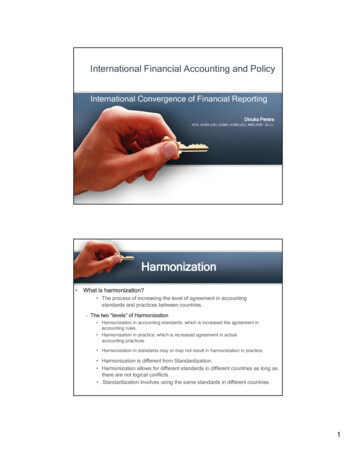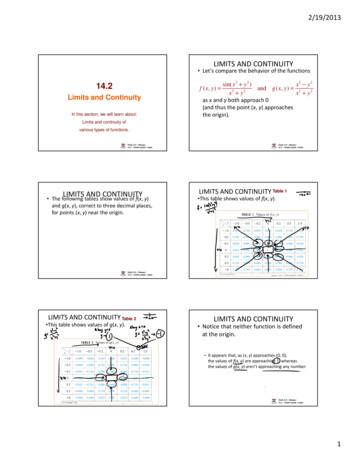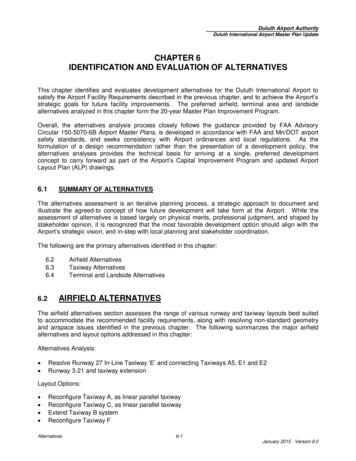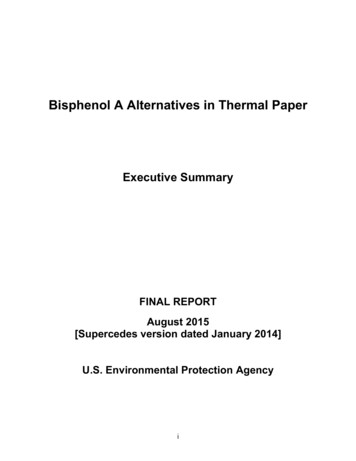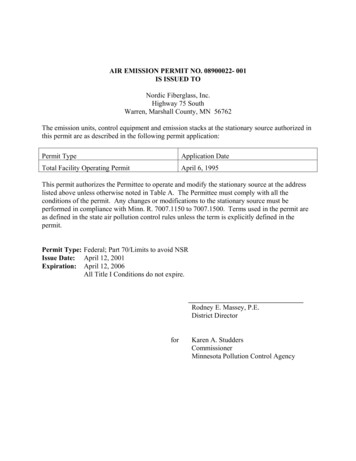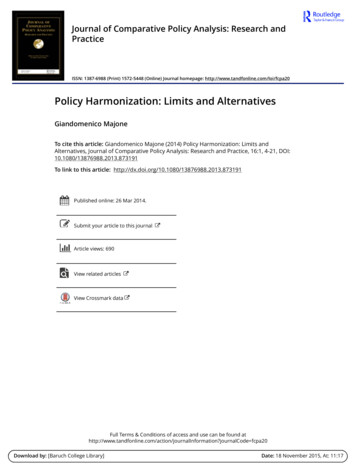
Transcription
Journal of Comparative Policy Analysis: Research andPracticeISSN: 1387-6988 (Print) 1572-5448 (Online) Journal homepage: http://www.tandfonline.com/loi/fcpa20Policy Harmonization: Limits and AlternativesGiandomenico MajoneTo cite this article: Giandomenico Majone (2014) Policy Harmonization: Limits andAlternatives, Journal of Comparative Policy Analysis: Research and Practice, 16:1, 4-21, DOI:10.1080/13876988.2013.873191To link to this article: ished online: 26 Mar 2014.Submit your article to this journalArticle views: 690View related articlesView Crossmark dataFull Terms & Conditions of access and use can be found tion?journalCode fcpa20Download by: [Baruch College Library]Date: 18 November 2015, At: 11:17
Journal of Comparative Policy Analysis, 2014Vol. 16, No. 1, 4–21, loaded by [Baruch College Library] at 11:17 18 November 2015Discourse and DialoguePolicy Harmonization: Limits andAlternativesGIANDOMENICO MAJONEDepartment of Public Policy, European University Institute, Grassina, Florence 50015, ItalyABSTRACT Globalization is an important reason for the current interest in the harmonization ofnational policies. In the European Community/Union harmonization of the national laws and policiesof the member states was one of three legal techniques the Rome Treaty made available for establishing and maintaining a common market. The long history of policy harmonization in the EC/EUprovides a good empirical basis for a more general analysis of the benefits and costs of a centralizedapproach to transnational policymaking. The main alternative to centralized harmonization is competition among different approaches to comparable policy problems.Keywords: harmonization; policymaking; globalization; EC; EUHarmonization and Its ModesHarmonization may be defined as making the regulatory requirements or governmentalpolicies of different jurisdictions identical or at least more similar. It is one response to theproblems arising from policy/regulatory differences among political units; it is also oneform of inter-governmental cooperation. A “harmonization claim”, according to DavidLeebron (1996), is a normative assertion that the differences in the laws and policies oftwo, or more, jurisdictions should be reduced: either by assigning decisions to a commonpolitical authority; or by different countries adopting similar laws and policies, even in theabsence of such a common authority. Leebron distinguishes four main types of harmonization. First, harmonization of specific rules and regulations prescribing how certainactivities should be performed – e.g. pollution regulations for chemical factories can bemade more similar in different countries, or different jurisdictions of the same country.Second, more general governmental policy objectives – e.g. concerning the ambient airquality standards, or minimum occupational health and safety standards to be maintained– can be harmonized. A third type of harmonization concerns certain general principlesGiandomenico Majone is currently Professor of Public Policy, Emeritus, at the European University Institute.Before joining EUI, he held teaching/research positions at a number of European and American institutions,including Yale, Harvard and Rome University. Since leaving EUI, he has been a Visiting Professor at the MaxPlanck Institute in Cologne; at Nuffield College, Oxford; at the Center for West European Studies, University ofPittsburgh; and at the Department of Government, London School of Economics, as Centennial Professor.Correspondence Address: Giandomenico Majone, Department of Public Policy, European University Institute,Via Lappeggi, 26, Grassina, FI 50015, Italy. Email: giand.majone@tin.it 2014 The Editor, Journal of Comparative Policy Analysis: Research and Practice
Downloaded by [Baruch College Library] at 11:17 18 November 2015Policy Harmonization5that are to be followed in policymaking. Thus, the “polluter pays principle”, aiming at theinternalization of pollution costs, was adopted by both the European Community andOrganisation for Economic Co-operation and Development (OECD) in the 1970s. Morerecently, and more controversially, the European Union adopted the PrecautionaryPrinciple as the basic approach in risk regulation – a principle which was howeverrejected by the World Trade Organization, and by most developing and developedcountries, including the US (Majone 2005: 124–142). The fourth category concerns theharmonization of structures and procedures, often as a means of reinforcing other types ofharmonization. Thus the monopoly of legislative initiative enjoyed by the EU executive,the European Commission, since the 1957 Treaty of Rome, was clearly meant to facilitate(or even to make possible) the first kind of harmonization: harmonization of the nationalpolicies of the member states.Here I am mainly interested in policy harmonization, but the distinctions made abovecan be quite helpful in the analysis of specific harmonization problems. On the other hand,the taxonomy presented so far assumes only one type of harmonization: ex ante harmonization, achieved by a centralized authority, or by different governments or sub-nationaljurisdictions. But even more important for the present argument is ex post harmonizationachieved through a variety of competitive processes. In this second, ex post, senseharmonization may be viewed as an aspect of the problem of optimal policy areas.Ex Post Harmonization through Policy CompetitionIn an important book on politics and public finance the Canadian economist Albert Breton(1996) argues that democratic governments compete with one another because they haveto respond to their citizens’ interests and preferences. In fact, inter-jurisdictional competition has been a key feature of the history of the Old Continent, with the European statessystem of the early modern age preserving important aspects of the cooperative competition which characterized the Middle Ages. Individuals and whole populations sometimes“voted with their feet” by shifting their allegiance to that country which was governedbest. Hence the fairly rapid diffusion of policy and institutional innovations throughoutthe continent in the period preceding the full development of the national state (Jones1987). Unfortunately, the prophets of European integration were too concerned with thetragic consequences of twentieth century nationalism to pay attention to the earlier historyof Europe. As a consequence, their opposition to nationalism did not lead them to explorealternative ways of organizing inter-state relations, but rather to transfer as much aspossible of the received national model of statehood to the supranational level. Hencetheir preference for positive integration, legal centralism, and ex ante harmonization ofnational policies at the supranational level. Quite revealing in this respect is the preferencefor total harmonization – i.e. for measures designed to regulate exhaustively a givenproblem to the exclusion of previously existing national measures – in the early stages ofthe integration process. The EU’s harmonization bias is still evident enough to havecaught the attention of Breton, who in his Competitive Governments criticizes the EUfor what he calls its excessive policy harmonization:I believe that the European Union is quite stable but that the stability has beenacquired by the virtual suppression of intercountry competition through excessivepolicy harmonization . To prevent the occurrence of instability, competition is
6G. MajoneDownloaded by [Baruch College Library] at 11:17 18 November 2015minimized through the excessive harmonization of a substantial fraction of social,economic, and other policies . If one compares the degree of harmonization inEurope with that in Canada, the United States, and other federations, one isimpressed by the extent to which it is greater in Europe than in the federations.(Breton 1996: 275–276)Today we know that even excessive harmonization has not been sufficient to ensure thestability of the EU. Indeed, one could argue that excessive harmonization has been theimmediate cause of the present instability: monetary union is, after all, an extreme form oftotal harmonization, see below. At least since the Cassis de Dijon judgment1 in 1979,attempts have been made to reduce the dependency on harmonization as the main tool ofpolicy integration in Europe. Indeed, the principle of mutual recognition was supposed toreduce the need for ex ante, top-down harmonization, and to facilitate regulatory competition among the member states. Supposedly a cornerstone of the Single Market programme, mutual recognition requires member states to recognize regulations made byother EU members as being essentially equivalent to their own, thus allowing activitiesthat are lawful in one member state to be freely pursued throughout the Union. In thisway, a virtuous circle of regulatory competition would be stimulated, which should raisethe quality of all regulation and drive out rules offering protection that consumers do not,in fact, require. The end result would be ex post harmonization, achieved throughcompetitive processes rather than by administrative measures. However, the high hopesraised by the Cassis de Dijon judgment and by what appeared to be the Commission’sstrong endorsement of this doctrine of the EU Court of Justice were largely disappointed.For political, ideological, and bureaucratic reasons, ex post, market-driven harmonizationwas never allowed to seriously challenge the dominant position of centralized, top-downharmonization. While the Cassis doctrine was greeted enthusiastically at a time when thepriority was to meet the deadline of the Single Market (“Europe ’92”) project, institutionaland political interests militate against wholehearted support of mutual recognition andregulatory competition. Instead of viewing competition as a discovery procedure (Hayek1984), the tendency has always been to assert that integration can be only one way toprevent a “Europe of Bits and Pieces” (Curtin 1993). In a sense, the reluctance ofpoliticians and bureaucrats to rely on competition is understandable, since “competitionis valuable only because, and so far as, its results are unpredictable and on the wholedifferent from those which anyone has, or could have, deliberately aimed at thegenerally beneficial effects of competition must include disappointing or defeating someparticular expectations or intentions” (Hayek 1984: 255).The Open Method of Coordination (OMC), codified and endorsed by the LisbonEuropean Council in March 2000, was another attempt to add a competitive dimensionto the traditional methods of integration. The philosophy underlying the OMC and related“soft law” methods is that each state should be encouraged to experiment on its own, andto craft solutions to fit its national context. Advocates of the new approach argue that theOMC can be effective despite – or even because of – its open-ended, non-binding, nonjusticiable qualities (Trubek and Trubek 2005). In fact, the new method seems to havefallen far short of expectations even in areas where one might have presumed it to haveyielded the most significant results. Many observers judge the whole OMC procedure tobe too bureaucratic to stimulate genuine interstate competition.
Downloaded by [Baruch College Library] at 11:17 18 November 2015Policy Harmonization7The evidence from these two attempts to move beyond harmonization in a systematicway suggests that the notion of competitive governments is foreign to the ideology ofEuropean integration espoused by the founding fathers. It is of course true that rules onmarket competition have always been a key element of EU law, but a moment’s reflectionshows that the reason for the importance attached to such rules is strictly utilitarian: not acommitment to a genuine free-market philosophy, but the realistic assessment that itwould be impossible to integrate a group of heavily regulated economies without limitations on the interventionism of the national governments (Majone 2009: 96–97). What isat any rate clear is that competition between different national approaches to economicand social regulation has played hardly any role in the European integration process.Indeed, a distinguished specialist of EU law has argued that competition among regulatorsis incompatible with the notion of undistorted competition in the internal Europeanmarket. Hence the UK – the member state which has most consistently defended thebenefits of inter-state competition – has been accused of subordinating individual rightsand social protection to a free-market philosophy incompatible with the basic aspirationsof the European Community/Union: “Competition between regulators on this perspectiveis simply incompatible with the EC’s historical mission” (Weatherill 1995: 180).In this context it is important to keep in mind that governments operating in a commonmarket cannot compete vigorously unless the authority to make economic policy remainslargely in their hands, while the supranational institutions must have the instruments toprevent the national governments using their regulatory authority to erect trade barriersagainst the goods and services from other member states. According to Weingast (1995), acommon market, national responsibility for the economy, monitoring by the supranationallevel, and tight budget constraints are crucial conditions of economic development. Inaddition to a game-theoretic argument, this American political economist provides interesting historical evidence in support of his thesis. Thus, the enormous expansion of theAmerican economy during the nineteenth century was based on the division of labourbetween the federal state and the states of the federation. The federal government wasresponsible for establishing and maintaining the common market, but before the 1880s itinterfered little in economic affairs, while the states were the promoters and entrepreneursof economic development. Also Louis Hartz writes in his classic study of the economicpolicy of the state of Pennsylvania between 1776 and 1860: “Despite the significantrestrictions which the federal constitution imposed upon the states, it reserved to them,both by implication in the enumerated powers of the [federal] government and by theexpress provisions of the Tenth Amendment, a large authority to deal with economicissues” (Hartz 1948: 3–4). Even the stunning economic growth of modern China, according to Weingast (1995: 21–24), seems to be due to the central government’s acceptance ofthe loss of political control over regional economic policymaking. The degree of supportof decentralization among the Peking authorities led to a variety of experiments ineconomic development. As these proved successful, and the central government did notrevoke them, they were expanded and imitated.By way of contrast, we saw that Albert Breton came to the conclusion that in the EUinter-country competition has been virtually suppressed through excessive policy (ex ante)harmonization. More generally, the Canadian economist suggests that part of the widespread opposition to the idea that domestic governments, national and internationalagencies, associations of various kinds, vertical and horizontal networks, and so on,should compete among themselves derives from the notion that competition is
Downloaded by [Baruch College Library] at 11:17 18 November 20158G. Majoneincompatible with, even antithetical to, cooperation. Breton cogently argues that thisperception is mistaken. Excluding the case of collusion, cooperation and competitioncan and generally do coexist, so that the presence of one is no indication of the absence ofthe other. In particular, the observation of cooperation and coordination does not per sedisprove that the underlying determining force may be competition. If one thinks ofcompetition not as the state of affairs neoclassical theory calls “perfect competition”,but as an activity – à la Schumpeter, Hayek, and other Austrian economists who developed the model of entrepreneurial competition – then it becomes plain that “the entrepreneurial innovation that sets the competitive process in motion, the imitation that follows,and the Creative Destruction that they generate are not inconsistent with cooperativebehaviour and the coordination of activities” (Breton 1996: 33). Given the appropriatecompetitive stimuli, political entrepreneurs, like their business counterparts, will consultwith colleagues at home and abroad, collaborate with them on certain projects, harmonizevarious activities, and in the extreme case integrate some operations – all actionscorresponding to what is generally meant by cooperation and coordination.Exit and Voice as Alternative Mechanisms of CompetitionAs was mentioned in the preceding section, inter-jurisdictional competition in medievaland early modern Europe was activated by exit: individuals and whole populationssometimes “voted with their feet” by shifting their allegiance to that city or countrywhich was governed best; hence the fairly rapid diffusion of policy and institutionalinnovations throughout the continent in the period preceding the full development of thenational state. However, the rise of the modern welfare state has significantly increased theeconomic and social costs of the exit option. In advanced modern economies competitionstimulated by exit will take place mostly at the sub-national level, between differentcommunities. According to the so-called Tiebout hypothesis, inter-jurisdictional competition results in communities supplying the goods and services individuals demand, andproducing them in an efficient manner. In Tiebout’s model communities below theoptimum size seek to attract new residents while those above optimum size do theopposite. As a result, the population distributes itself in such a way that in each community all residents tend to have identical, or at least similar, preferences. The idea ofhorizontal intergovernmental competition seems to have entered the literature of publicfinance and public choice with Tiebout’s (1956) seminal paper on local public goods. But,Breton (1996) points out, the effectiveness of the entry and exit mechanism for intergovernmental competition may be quite weak beyond the local level because of thelimited mobility of persons across national borders, as well as for other more technicalreasons. Therefore, the notion of inter-jurisdictional competition has to be extended toapply to situations where Tiebout’s potential entry and exit mechanisms do not workeffectively, for instance because mobility is limited by language and/or cultural and socialcleavages, as in the EU. One such extension is Salmon’s external benchmark mechanism.This extension consists in assuming that the citizens of a jurisdiction can use informationabout the goods and services supplied in other jurisdictions, or in other comparablecountries, as a benchmark to evaluate the performance of their own government; andthat the same citizens decide to support or to oppose their government on the basis of thatassessment. The first assumption corresponds, more or less, to the idea of informationexchange also underlying the EU’s Open Method of Coordination, but since national
Downloaded by [Baruch College Library] at 11:17 18 November 2015Policy Harmonization9parliaments are largely excluded from the OMC process, European citizens are unable inpractice to use information about the performance of other member states to induce theirgovernment to improve its own performance.It should also be noted that in any jurisdiction there always are many subgroups whosepreferences with respect to certain goods and services, and corresponding policies, are thesame as those of subgroups in other jurisdictions, even in other countries. This observation has two significant implications. First, as Breton points out, one can assume that thestimulus to compete based on external benchmarks exists. The strength of the mechanismwill naturally depend on the ability of citizens to make inter-governmental performancecomparisons. To quote Breton (1996: 234–235): “The existence of ‘iron’ or ‘bamboo’curtains – measures designed to ensure that policy implemented elsewhere is not used asexternal norms to evaluate internal performance – is evidence that the Salmon mechanismis not only operative but powerful”. The second implication is that any discussion aboutthe benefits and costs of policy harmonization – the main costs resulting from the fact thatthe harmonized policy is a sort of average and as such it may match the preferences ofsome subgroup only in a very rough sense – must start from the realization that policyharmonization can take place in the context of two very different modes of integration: byterritory or by function.Functional vs. Territorial IntegrationA functional approach to international integration was advocated by David Mitrany in the1940s. A territorial union, Mitrany argued, “would bind together some interests which arenot of common concern to the group, while it inevitably cuts asunder some interests ofcommon concern to the group and those outside it”. To avoid such “twice-arbitrarysurgery” it is necessary to proceed by “binding together those interests which arecommon, where they are common, and to the extent to which they are common”. Thusthe essential principle of a functional organization of international activities “is thatactivities would be selected specifically and organized separately, each according to itsnature, to the conditions under which it has to operate, and to the needs of the moment”(citations in Eilstrup-Sangiovanni 2006: 57–58). On the other hand, Mitrany was scepticalabout the advantages of political union. His main objection to schemes for continentalunions was that “the closer the union the more inevitable would it be dominated by themore powerful member” (in Eilstrup-Sangiovanni 2006: 47). This point, which has beenlargely overlooked by later writers on European integration, is directly linked to thediscussion of Germany as a potential (if reluctant) hegemon (Majone 2014: chapter 8).Mitrany’s ideas were resurrected and applied to the case of European integration byRalph Dahrendorf in the 1970s. While still a member of the European Commission,Dahrendorf wrote a series of newspaper articles (published in 1973 under the nom deplume Weiland Europa) in which he severely criticized the European institutions and theirstrategy of “integration by stealth” – political integration under the guise of economicintegration. The first of the four principles he advocated as a means of accelerating theprocess of political integration was that it is more important to solve problems than tocreate institutions. This was a clear, if implicit, criticism of federalists like Paul-HenriSpaak and Jean Monnet, for whom what mattered most was the creation of Europeaninstitutions – regardless of what these institutions might do. It was his third principle thatexpressed the idea of integration à la carte, meaning that “everyone does what he wants
Downloaded by [Baruch College Library] at 11:17 18 November 201510G. Majoneand no one must participate in everything”, a situation that “though far from ideal issurely much better than avoiding anything that cannot be cooked in a single pot” (cited inGillingham 2003: 91–92). Concretely this meant that there would be common Europeanpolicies in areas where the member states have a common interest, but not otherwise.This, said Dahrendorf, must become the general rule rather than the exception if we wishto prevent continuous demands for special treatment, destroying in the long run thecoherence of the entire system – a prescient anticipation of the present practice of movingahead by granting opt-outs from treaty obligations. Dahrendorf’s suggestion that under themode of integration he envisaged “everyone does what he wants” should not be takenliterally, of course: even a mere free-trade area presupposes some generally accepted rules.The key point is that “no one must participate in everything”; hence integration à la carte,although it presupposes some general rules accepted by everybody, does not assume acommon final destination – not even in the sense of an open-ended process of “ever closerunion”. Beyond the common agreement to form, say, a customs union with elements of acommon market, member states would be free to cooperate in specific functional areas onthe basis of shared interests.Neither Mitrany nor Dahrendorf based their ideas of functional integration on formaltheory. Such a theory is available today; it is the economic theory of clubs, originallydeveloped by James Buchanan (1965), and later applied by Alessandra Casella (1996) tostudy the interaction between expanding markets and the provision of product standards.Casella argues, inter alia, that if we think of standards as being developed by communitiesof users, then “opening trade will modify not only the standards but also the coalitionsthat express them. As markets . expand and become more heterogeneous, differentcoalitions will form across national borders, and their number will rise” (Casella 1996:149). The relevance of these arguments extends well beyond the narrow area of standardsetting. In fact, Casella’s emphasis on heterogeneity as the main force against harmonization and for the multiplication of “clubs” suggests an attractive theoretical basis for themode of integration advocated by Dahrendorf and Mitrany. To see this more clearly weneed to recall a few definitions and key concepts from Buchanan’s theory of clubs.Public (or collective) goods, such as national defence or environmental quality, arecharacterized by two properties: first, it does not cost anything for an additional individualto enjoy the benefits of the public goods once they are produced (joint-supply property);and, second, it is difficult or impossible to exclude individuals from the enjoyment of suchgoods (non-excludability). A “club good” is a public good from whose benefits individuals may be excluded; an association established to provide an excludable public good isa club. Two elements determine the optimal size of a club. One is the cost of producingthe club good – in a large club this cost is shared over more members. The second elementis the cost to each club member of the good not meeting precisely his or her individualneeds or preferences. The latter cost is likely to increase with the size of the club. Theoptimal size is determined by the point where the marginal benefit from the addition ofone new member – i.e. the reduction in the per capita cost of producing the good – equalsthe marginal cost caused by a mismatch between the characteristics of the good and thepreferences of the individual club members. If the preferences and the technologies for theprovision of club goods are such that the number of clubs that can be formed in a societyof given size is large, then an efficient allocation of such excludable public goods throughthe voluntary association of individuals into clubs is possible. With many alternative clubsavailable each individual can guarantee herself a satisfactory balance of benefits and costs,
Downloaded by [Baruch College Library] at 11:17 18 November 2015Policy Harmonization11since any attempt to discriminate against her would induce her exit into a competing club.The important question is: what happens as the complexity of the society increases,perhaps as the result of the integration of previously separate markets? It has beenshown that under plausible hypotheses the number of clubs tends to increase as well,since the greater diversity of needs and preferences makes it efficient to produce a broaderrange of club goods, such as standards. The two main forces driving the results ofCasella’s model are heterogeneity among the economic agents, and transaction costs –the costs of trading under different standards. Harmonization is the optimal strategy whentransaction costs are high enough, relative to gross returns, to prevent a partition of thecommunity of users into two clubs that reflect their needs more precisely. Hence harmonization occurs in response to market integration, but possibly only for an intermediaterange of productivity in the production of standards, and when heterogeneity is not toogreat.Think now of a society composed not of individuals, but of independent states.Associations of independent states (alliances, leagues, confederations) are typically voluntary, and their members are exclusively entitled to enjoy certain benefits produced by theassociation, so that the economic theory of clubs is applicable to this situation. In fact,since excludability is more easily enforced in the context envisaged here, many goods thatare purely public at the national level (e.g. national defence) become club goods at theinternational level (Majone 2005: 20–21). The club goods in question could be collectivesecurity, policy coordination, common technical standards – or a common currency:several proposals on how to resolve the euro crisis boil down to changing the nature ofmonetary union, from a public good to a club good. In these and many other cases,countries unwilling to share the costs are usually excluded from the benefits of inter-statecooperation in a particular project. Now, as an association of states expands, becomingmore diverse in its preferences, the cost of uniformity in the provision of such goods – e.g.the total harmonization of monetary policies – can escalate dramatically. The theorypredicts an increase in the number of voluntary associations to meet the increased demandof club goods more precisely tailored to the different requirements of various subsets ofmore homogeneous states. In sum, the key idea
Harmonization may be defined as making the regulatory requirements or governmental . [Baruch College Library] at 11:17 18 November 2015 . that are to be followed in policymaking. Thus, the "polluter pays principle", aiming at the . but rather to transfer as much as possible of the received national model of statehood to the .
